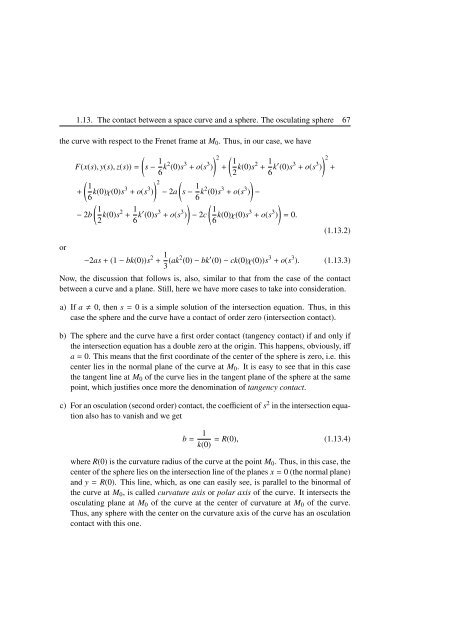Blaga P. Lectures on the differential geometry of - tiera.ru
Blaga P. Lectures on the differential geometry of - tiera.ru
Blaga P. Lectures on the differential geometry of - tiera.ru
Create successful ePaper yourself
Turn your PDF publications into a flip-book with our unique Google optimized e-Paper software.
1.13. The c<strong>on</strong>tact between a space curve and a sphere. The osculating sphere 67<br />
<strong>the</strong> curve with respect to <strong>the</strong> Frenet frame at M0. Thus, in our case, we have<br />
or<br />
F(x(s), y(s), z(s)) =<br />
�<br />
1<br />
+<br />
− 2b<br />
�<br />
s − 1<br />
6 k(0)χ(0)s3 + o(s 3 )<br />
� 2<br />
6 k2 (0)s 3 + o(s 3 �2 )<br />
− 2a<br />
�<br />
s − 1<br />
�<br />
1<br />
2 k(0)s2 + 1<br />
6 k′ (0)s 3 + o(s 3 �<br />
)<br />
�<br />
1<br />
+<br />
6 k2 (0)s 3 + o(s 3 )<br />
− 2c<br />
2 k(0)s2 + 1<br />
�<br />
−<br />
�<br />
1<br />
6 k(0)χ(0)s3 + o(s 3 �<br />
)<br />
6 k′ (0)s 3 + o(s 3 �2 )<br />
= 0.<br />
+<br />
(1.13.2)<br />
−2as + (1 − bk(0))s 2 + 1<br />
3 (ak2 (0) − bk ′ (0) − ck(0)χ(0))s 3 + o(s 3 ). (1.13.3)<br />
Now, <strong>the</strong> discussi<strong>on</strong> that follows is, also, similar to that from <strong>the</strong> case <strong>of</strong> <strong>the</strong> c<strong>on</strong>tact<br />
between a curve and a plane. Still, here we have more cases to take into c<strong>on</strong>siderati<strong>on</strong>.<br />
a) If a � 0, <strong>the</strong>n s = 0 is a simple soluti<strong>on</strong> <strong>of</strong> <strong>the</strong> intersecti<strong>on</strong> equati<strong>on</strong>. Thus, in this<br />
case <strong>the</strong> sphere and <strong>the</strong> curve have a c<strong>on</strong>tact <strong>of</strong> order zero (intersecti<strong>on</strong> c<strong>on</strong>tact).<br />
b) The sphere and <strong>the</strong> curve have a first order c<strong>on</strong>tact (tangency c<strong>on</strong>tact) if and <strong>on</strong>ly if<br />
<strong>the</strong> intersecti<strong>on</strong> equati<strong>on</strong> has a double zero at <strong>the</strong> origin. This happens, obviously, iff<br />
a = 0. This means that <strong>the</strong> first coordinate <strong>of</strong> <strong>the</strong> center <strong>of</strong> <strong>the</strong> sphere is zero, i.e. this<br />
center lies in <strong>the</strong> normal plane <strong>of</strong> <strong>the</strong> curve at M0. It is easy to see that in this case<br />
<strong>the</strong> tangent line at M0 <strong>of</strong> <strong>the</strong> curve lies in <strong>the</strong> tangent plane <strong>of</strong> <strong>the</strong> sphere at <strong>the</strong> same<br />
point, which justifies <strong>on</strong>ce more <strong>the</strong> denominati<strong>on</strong> <strong>of</strong> tangency c<strong>on</strong>tact.<br />
c) For an osculati<strong>on</strong> (sec<strong>on</strong>d order) c<strong>on</strong>tact, <strong>the</strong> coefficient <strong>of</strong> s 2 in <strong>the</strong> intersecti<strong>on</strong> equati<strong>on</strong><br />
also has to vanish and we get<br />
b = 1<br />
= R(0), (1.13.4)<br />
k(0)<br />
where R(0) is <strong>the</strong> curvature radius <strong>of</strong> <strong>the</strong> curve at <strong>the</strong> point M0. Thus, in this case, <strong>the</strong><br />
center <strong>of</strong> <strong>the</strong> sphere lies <strong>on</strong> <strong>the</strong> intersecti<strong>on</strong> line <strong>of</strong> <strong>the</strong> planes x = 0 (<strong>the</strong> normal plane)<br />
and y = R(0). This line, which, as <strong>on</strong>e can easily see, is parallel to <strong>the</strong> binormal <strong>of</strong><br />
<strong>the</strong> curve at M0, is called curvature axis or polar axis <strong>of</strong> <strong>the</strong> curve. It intersects <strong>the</strong><br />
osculating plane at M0 <strong>of</strong> <strong>the</strong> curve at <strong>the</strong> center <strong>of</strong> curvature at M0 <strong>of</strong> <strong>the</strong> curve.<br />
Thus, any sphere with <strong>the</strong> center <strong>on</strong> <strong>the</strong> curvature axis <strong>of</strong> <strong>the</strong> curve has an osculati<strong>on</strong><br />
c<strong>on</strong>tact with this <strong>on</strong>e.












